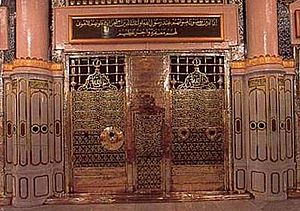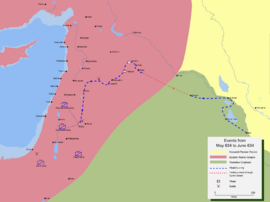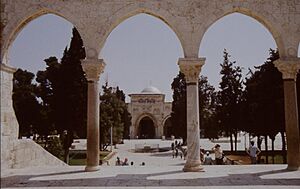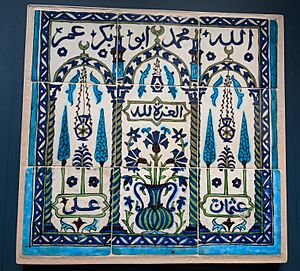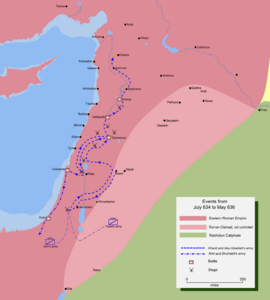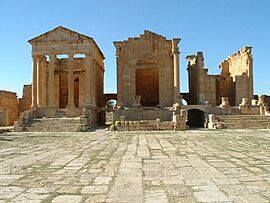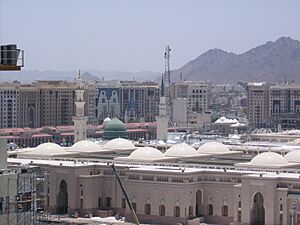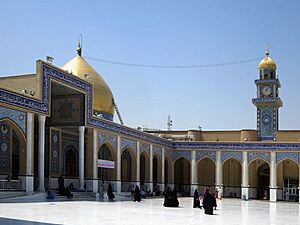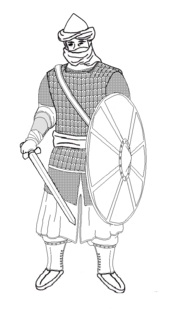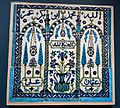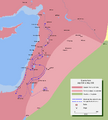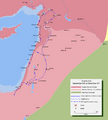Rashidun Caliphate facts for kids
Quick facts for kids
Rashidun Caliphate
|
|||||||||||||||
|---|---|---|---|---|---|---|---|---|---|---|---|---|---|---|---|
| 632–661 | |||||||||||||||
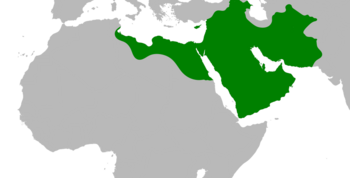
The Rashidun Caliphate at its greatest extent, under Caliph Uthman, c. 654
|
|||||||||||||||
| Status | Caliphate | ||||||||||||||
| Capital | Medina (632–656) Kufa (656–661) |
||||||||||||||
| Official languages | Arabic | ||||||||||||||
| Common languages | Various regional languages | ||||||||||||||
| Religion | Islam | ||||||||||||||
| Government | Caliphate | ||||||||||||||
| Caliph | |||||||||||||||
|
• 632–634
|
Abu Bakr (first) | ||||||||||||||
|
• 634–644
|
Umar | ||||||||||||||
|
• 644–656
|
Uthman | ||||||||||||||
| History | |||||||||||||||
|
• Succession to Muhammad
|
632 | ||||||||||||||
| 633–654 | |||||||||||||||
|
• Ascension of Umar
|
634 | ||||||||||||||
|
• Assassination of Umar and Ascension of Uthman
|
644 | ||||||||||||||
|
• Assassination of Uthman and Ascension of Ali
|
656 | ||||||||||||||
|
• Assassination of Ali
|
661 | ||||||||||||||
|
• First Fitna (internal conflict) ends after Hasan's abdication
|
661 | ||||||||||||||
| Area | |||||||||||||||
| 655 | 6,400,000 km2 (2,500,000 sq mi) | ||||||||||||||
| Currency | |||||||||||||||
|
|||||||||||||||
The Rashidun Caliphate (Arabic: ٱلْخِلَافَةُ ٱلرَّاشِدَةُ, romanized: al-Khilāfah ar-Rāšidah) was the first caliphate to follow the Islamic prophet Muhammad. It was led by the first four caliphs after Muhammad passed away in 632 CE. During its time, this empire was a very strong power in West Asia and Northeast Africa.
The caliphate started after Muhammad's death in June 632. There was a discussion about who should lead next. Abu Bakr, a close friend of Muhammad, was chosen as the first caliph in Medina. He began to expand the caliphate across the Arabian Peninsula. He ruled for a short time and passed away in August 634.
Umar then became the leader. Under Umar, the caliphate grew very quickly. It came to rule over much of the Byzantine Empire and almost all of the Sasanian Empire. Umar was killed in November 644.
Next, Uthman was chosen by a special committee. Under Uthman, the caliphate finished conquering Persia in 651. It also continued to expand into Byzantine lands. However, some groups rebelled during his rule, and he was killed in June 656.
Ali then became the caliph and moved the capital to Kufa. Ali faced a civil war called the First Fitna. This was because Mu'awiya, a relative of Uthman and governor of Syria, did not accept Ali's leadership. Another group, the Kharijites, also rebelled against both Ali and Mu'awiya. This war led to the end of the Rashidun Caliphate. The Umayyad Caliphate was then started by Mu'awiya in 661. This civil war also created a lasting split between Sunni and Shia Muslims. Shia Muslims believe Ali was the first rightful caliph and Imam after Muhammad.
The Rashidun Caliphate had 25 years of fast military growth. This was followed by five years of internal conflict. The Rashidun Army had over 100,000 soldiers at its largest. By the 650s, the caliphate controlled the Arabian Peninsula, the Levant, parts of Central Asia, and North Africa. The four Rashidun caliphs were chosen by a small group of important companions of the Prophet. This group was called shūrā (Arabic: شُورَى, meaning consultation).
Contents
- What "Rashidun" Means
- How the Caliphate Started
- History of the Caliphate
- How the Government Worked
- Economy
- Public Works
- How People See the Caliphate Now
- Military
- List of Rashidun Caliphs
- Images for kids
- See also
- Sources
What "Rashidun" Means
The Arabic word rāshidūn means "rightly-guided." In Sunni Islam, the rule of these four caliphs is seen as "rightly-guided." This means it's a good example (sunnah) to follow. Shia Muslims do not use this term because they do not accept the first three caliphs as rightful leaders.
How the Caliphate Started
After Muhammad passed away in 632 CE, his companions in Medina discussed who should lead the Muslim community. Umar and Abu Ubayda ibn al-Jarrah promised their loyalty to Abu Bakr. Other groups soon followed. Abu Bakr took the title Khalīfaṫ Rasūl Allāh, meaning "Successor of the Messenger of God," or simply caliph.
Abu Bakr started campaigns to spread Islam. First, he had to bring the Arabian tribes back under control. Some tribes believed their loyalty ended with Muhammad's death. Abu Bakr said they had joined a larger ummah (أُمَّـة, community), and he was the new head. The caliphs were not kings. Their leadership was based on their good qualities.
Sunni Muslims believe all four Rashidun Caliphs were connected to Muhammad through marriage. They were also early Muslims and close friends of Muhammad. These caliphs are known as the Rashidun, or "Rightly Guided" caliphs.
History of the Caliphate
Abu Bakr's Rule (632–634)
Becoming Caliph
After Muhammad's death in June 632, a meeting happened in Medina. The local people, called the Ansar, met to choose a new leader. Abu Bakr and Umar, two important companions of Muhammad, went to this meeting. Abu Bakr warned that choosing a leader outside Muhammad's tribe, the Quraysh, could cause problems. He then offered Umar and another companion as choices. Umar quickly pledged his loyalty to Abu Bakr, and others followed.
Abu Bakr was mostly accepted as the leader. However, some, like Ali ibn Abi Talib, at first did not accept his authority. Ali was Muhammad's cousin and son-in-law. After six months, Ali made peace with Abu Bakr and accepted his leadership.
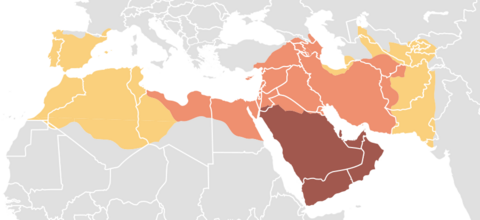
Wars of Unity
Soon after Muhammad's death, some tribes in the Arabian Peninsula stopped following Islam. Some refused to pay the religious tax. Other leaders claimed to be prophets. Abu Bakr believed all tribes were part of the Muslim community. This led to a series of conflicts called the Ridda wars.
Abu Bakr divided his army into groups. The strongest group, led by Khalid ibn al-Walid, fought the most powerful rebels. After many battles, Khalid defeated a false prophet named Musaylimah. By March 633, the Arabian Peninsula was united under the caliph in Medina.
Moving into Persia and Syria
After uniting Arabia, Abu Bakr began to move into the lands of the Byzantine Empire and the Sasanian Empire. He sent General Khalid ibn al-Walid to invade the Sasanian Empire in 633. He also sent armies to invade the Roman province of Syria. Khalid later moved to the Syrian front in 634.
Umar's Rule (634–644)
Before he passed away in August 634, Abu Bakr chose Umar (who ruled from 634 to 644) as his successor. Umar took the title amir al-mu'minin, meaning "Commander of the Believers." This became the usual title for caliphs. Umar continued the wars of conquest. He pushed deeper into the Sasanian Empire, north into Byzantine lands, and into Egypt. These areas were rich and controlled by strong states. However, long wars between the Byzantines and Persians had made both sides weak. The Islamic armies won easily. By 640, they controlled all of Mesopotamia, Syria, and Palestine. Egypt was conquered by 642, and almost all of the Sasanian Empire by 643.
Umar also set up a system to manage the growing empire. He created the Diwan, a government office. The army was directly controlled and paid by the state. Importantly, Umar did not force non-Muslims to convert to Islam in the conquered lands. He let them keep their religion, language, and customs. He only appointed a governor (amir) and a financial officer. These new roles helped collect taxes that funded the empire.
Umar also started the Islamic calendar. It is a lunar calendar, and it begins in 622, the year Muhammad moved to Medina.
In 644, Umar was killed by an attacker while leading morning prayers.
Uthman's Rule (644–656)
Choosing Uthman
Before Umar died, he chose a committee of six men to pick the next caliph. All these men were from the Quraysh tribe.
The choices came down to two: Uthman and Ali. Ali was Muhammad's cousin and son-in-law. Uthman was from the Umayyad clan and was also Muhammad's son-in-law. Uthman was chosen as caliph.
Uthman ruled for twelve years. At first, he was very popular. But later, he faced more and more opposition. This opposition was led by people from Egypt and centered around Ali.
Even with internal problems, Uthman continued the wars of conquest. The Rashidun army conquered North Africa from the Byzantines. They also raided Spain and captured islands like Rhodes and Cyprus. The Rashidun army fully conquered the Sasanian Empire. Its eastern borders reached the lower Indus River.
Uthman's most lasting project was putting together the final version of the Qur'an. He made sure it was written clearly so non-Arabic speakers could read it easily.
Uthman's Death
A protest turned into a siege on Uthman's house. Uthman did not want to start a civil war. He tried to find a peaceful solution. The protesters returned, but then found an order to kill them. They believed the order came from Uthman. Uthman said he did not write it. The protesters then broke into his house and killed him while he was reading the Qur'an. It was later found that the order was part of a plan to overthrow him.
Ali's Rule (656–661)
Challenges and Divisions
After Uthman's death, Muhammad's cousin Ali (who ruled from 656 to 661) was chosen as caliph. He moved the capital to Kufa in Iraq. Ali then removed several governors, some of whom were Uthman's relatives.
People demanded revenge for Uthman's death. A large army, including Muhammad's widow Aisha, set out to fight those responsible. This led to the Battle of the Camel, the first battle between Muslims. Ali won this battle.
Then, Mu'awiya, a relative of Uthman and governor of Syria, also demanded revenge. Ali fought Mu'awiya's forces to a standstill at the Battle of Siffin. After this, Ali had to fight the Battle of Nahrawan against the Kharijites. They were former supporters who turned against him. Because of these internal problems, Ali's forces lost control of much of the caliphate's land to Mu'awiya.
In 661, Ali was killed by an attacker. This was part of a plan to kill several Islamic leaders to end the civil war.
Ali's son Hasan briefly became caliph for six months. He made an agreement with Mu'awiya to improve relations between their groups. The agreement said Mu'awiya would not name a successor. This meant the Muslim world would choose the next leader. However, Mu'awiya later broke this agreement and named his son Yazid I as his successor. Hasan was killed, and Mu'awiya started the Umayyad Caliphate, replacing the Rashidun Caliphate.
Military Expansion
The Rashidun Caliphate grew steadily. In 24 years, it conquered a huge area. This included Mesopotamia, the Levant, parts of Anatolia, and most of the Sasanian Empire.
Unlike the Persians, the Byzantines retreated to Anatolia after losing Syria. They also lost Egypt to the Rashidun army. However, the civil wars among Muslims slowed down the conquests. This gave the Byzantine Empire time to recover.
Conquering the Sasanian Empire
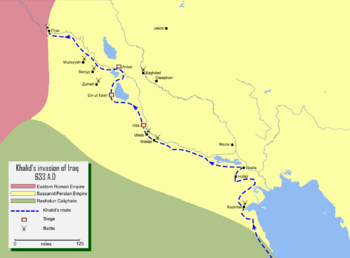
The first Islamic invasion of the Sasanian Empire began in 633. Caliph Abu Bakr sent his general, Khalid ibn al-Walid, to conquer Mesopotamia. Khalid won several important battles, and by July 633, most of Iraq was under Islamic control.
Khalid then left Mesopotamia to lead a campaign in Syria. The Persians tried to regain Mesopotamia. Umar sent more troops, and the Muslims won a major victory at the Battle of al-Qādisiyyah in 636. The Persian general was killed.
After this battle, the Arab Muslim armies moved towards the Persian capital, Ctesiphon. They captured the city quickly. They continued to push eastward, defeating more Persian armies. By the mid-7th century, the Arabs controlled all of Mesopotamia.
Caliph Umar initially did not want to send his troops beyond the Zagros mountains. However, the Persian government kept trying to regain lost lands. So, Umar decided to push forward. This led to the full conquest of the Sasanian Empire. The last strong Sasanian army was defeated at the Battle of Nihawānd in 641. This battle was called the "Victory of Victories" because it marked the end of the Sasanians.
By 642, Umar sent armies to conquer the rest of the Persian Empire. This included all of present-day Iran and other regions. During Uthman's rule, the caliphate's eastern borders reached the lower Indus River and the Oxus River.
Wars Against the Byzantine Empire
Conquering Byzantine Syria
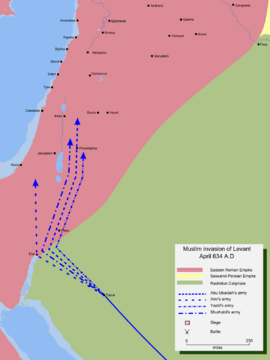
After Khalid secured Iraq, Abu Bakr sent four armies to Syria. Khalid later joined them and took overall command. The Byzantine army gathered at Ajnadayn. The Byzantines were defeated on July 30, 634, in the Battle of Ajnadayn. This opened the way for Muslims to capture central Syria. Damascus was conquered on September 19, 634.
When Umar became caliph, he put Abu Ubaidah ibn al-Jarrah in charge of the Muslim armies. The conquest of Syria continued. The last large Byzantine army was defeated at the Battle of Fahl in January 635. This was important for taking control of Palestine.
The Muslims then moved north towards Emesa. Emperor Heraclius sent an army to retake Damascus, but it was defeated. Emesa and Chalcis made peace for a year. But when the Muslims heard of more Byzantine troops, they attacked Emesa and captured it in March 636.
The Byzantines planned a large army to take back Syria. Khalid suggested gathering all Muslim forces at Yarmouk. The Muslims returned all the taxes they had collected and moved to Yarmouk. The Battle of Yarmouk lasted six days in August 636. The Muslims, though outnumbered, defeated the Byzantine army.
After this victory, the Muslims decided to conquer Jerusalem. The city surrendered in April 637 to Caliph Umar himself. Abu Ubaidah and Khalid then moved to northern Syria. They conquered Aleppo in October 637.
Taking Over Anatolia
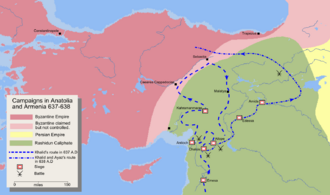
Abu Ubaidah and Khalid ibn al-Walid conquered northern Syria. They then moved north into Anatolia. They defeated a Roman army at the Battle of the Iron Bridge. Antioch surrendered on October 30, 637 CE. Parts of Anatolia, including Marash and Malatya, were conquered by Khalid in 638 CE.
During Uthman's rule, the Byzantines recaptured some forts. Muawiyah, the governor of Syria, sent an army into Anatolia in 647. They raided Cappadocia. In 650–651, a major attack into Cilicia forced the Byzantine Emperor to negotiate. The Taurus Mountains in Turkey became the western border of the Rashidun Caliphate in Anatolia.
Conquering Egypt

In 639, Egypt was part of the Byzantine Empire. However, it had been taken over by the Sasanian Empire just before. The Byzantine Empire was weak after losing Syria. So, conquering Egypt was easier. In 639, about 4,000 Rashidun soldiers led by Amr ibn al-As were sent to conquer Egypt. They quickly moved into the Nile Delta. The Byzantine troops retreated into walled towns.
The Muslims received more soldiers. In 640, they defeated a Byzantine army at the Battle of Heliopolis. Amr then moved towards Alexandria, which surrendered in November 641. The ease of this conquest was partly due to the weakness of the Byzantines.
In 645, during Uthman's rule, the Byzantines briefly took back Alexandria. But Amr recaptured it in 646. After this, the Byzantines did not try hard to get Egypt back. Some local Christians helped the Muslims, finding them more tolerant than the Byzantines.
Conquering the Maghreb
After the Byzantines left Egypt, the Exarchate of Africa became independent. Its leader, Gregory, ruled from Egypt's borders to Morocco. Abdullah ibn Sa'ad led raids into the west. Uthman allowed a full campaign to conquer the Exarchate.
A force of 10,000 soldiers was sent. The Rashidun army gathered in Barqa and marched west. They captured Tripoli and then advanced to Sufetula, Gregory's capital. In the battle, the Exarchate was defeated, and Gregory was killed. The people of North Africa then agreed to pay a yearly tribute. The Muslims made North Africa a vassal state instead of fully taking it over. After the tribute was paid, the Muslim forces went back to Barqa.
Campaign Against Nubia (Sudan)

A campaign against Nubia happened in 642 during Umar's rule. But it failed after the Makurians won the First Battle of Dongola. The Muslim army left Nubia. Ten years later, Uthman's governor of Egypt sent another army to Nubia. This army went deeper into Nubia and besieged the capital, Dongola. The Muslims damaged the cathedral, but Makuria also won this battle.
Since the Muslims could not defeat Makuria, they made a peace treaty with their king. Both sides agreed to let each other pass through their lands freely. Nubia agreed to give 360 slaves to Egypt each year. Egypt agreed to supply grain, horses, and textiles to Nubia.
Conquering Mediterranean Islands
During Umar's rule, the governor of Syria, Muawiyah I, asked to build a navy to invade Mediterranean islands. Umar said no because it was too risky for the soldiers. But when Uthman became caliph, he approved Muawiyah's request. In 650, Muawiyah attacked Cyprus. He conquered the capital, Constantia, and made a treaty with the local rulers.
Later, the Arabs re-invaded Cyprus in 654 with 500 ships. This time, 12,000 soldiers were left on the island, bringing it under Muslim control. After Cyprus, the Muslim fleet went to Crete and Rhodes and conquered them easily. From 652 to 654, the Muslims launched a naval campaign against Sicily and captured a large part of the island. Soon after, Uthman was killed, and the Muslims left Sicily. In 655, the Byzantine Emperor tried to attack the Muslims at Phoinike but was defeated.
How Conquered People Were Treated
Non-Muslims in conquered lands, like Jews, Zoroastrians, and Christians, were called dhimmis (protected people). They were allowed to practice their religion and manage their own community affairs. They were guaranteed safety and property. In return, they paid a tax and accepted Muslim rule. Dhimmis also had to pay the jizya tax.
The Rashidun caliphs tried to treat dhimmis fairly. They were protected by the Caliphate and were not expected to fight in wars. Sometimes, if there were not enough qualified Muslims, dhimmis were given important government jobs.
How the Government Worked
The basic government system was set up during Muhammad's time. Caliph Abu Bakr said, "If I order anything that goes against Allah's order, then do not obey me." This was a key idea for the Caliphate. Caliph Umar said, "O Muslims, straighten me with your hands when I go wrong." A Muslim man replied, "If you are not straightened by our hands, we will use our sword to straighten you!" Umar was happy to have such followers.
Provinces and Districts
Under Abu Bakr, the empire was not clearly divided. But under Umar, it was split into many provinces. These included:
- Arabia (Mecca and Medina)
- Iraq (Basra and Kufa)
- Jazira
- Syria
- Palestine
- Egypt
- Persia (Khorasan, Azerbaijan, and Fars)
Uthman later made Egypt one province and created a new one for North Africa. During Uthman's rule, the caliphate had twelve provinces.
Each province was divided into districts. A governor (Wāli) managed each district and main city. Other officers included:
- Katib: Chief Secretary
- Sahib-ul-Kharaj: Tax Collector
- Qadi: Chief Judge
The Caliph appointed all officers in writing. They had to read their instructions to the people in the main mosque.
Umar's general instructions to his officers were:
Remember, I have not appointed you as commanders and tyrants over the people. I have sent you as leaders instead, so that the people may follow your example. Give the Muslims their rights and not beat them lest they become abused. Do not keep your doors shut in their faces, lest the more powerful of them eat up the weaker ones.
To prevent corruption, Umar paid his staff high salaries. Governors received a lot of money each year.
Justice System
The justice system was set up by Umar. It stayed mostly the same throughout the Caliphate. Justice was given based on Islamic principles.
Qadis (judges) were appointed at all levels. They were chosen for their honesty and knowledge of Islamic law. Wealthy and high-status men were chosen and paid well to prevent bribery. Judges were not allowed to trade.
Choosing a Caliph
The four Rashidun caliphs were chosen by a small group of important members of the Quraysh tribe. This group was called shūrā (Arabic: شُـوْرَى, meaning consultation).
Historians say that the usual practice was for important men of a tribe to gather after a leader's death. They would then choose a new leader from among themselves. Candidates were often from the same family as the dead leader, but not always his sons. Capable men were preferred.
Sunni Beliefs
After Muhammad's death, Abu Bakr was chosen as caliph. Sunni Muslims believe the caliph is a political ruler. He is meant to rule according to Islamic law. The first four caliphs are called the Rashidun, or Rightly Guided Caliphs. This is because they are believed to have followed the Qur'an and Muhammad's example.
Accountability of Rulers
Islamic lawyers have discussed when it's okay to disobey or remove rulers. This happens if rulers are not meeting their duties under Islam.
Some scholars said that if rulers are unjust or ineffective, they should be removed by the Majlis al-Shura (consultative assembly). Others believed that if a caliph acts without caring for Islamic law, people should rebel.
Rule of Law
The principle of rule of law means everyone is subject to the same laws. A Qadi (Islamic judge) was not allowed to treat people differently based on religion, gender, or family. There were cases where caliphs had to appear before judges.
Economy
The Public Treasury
Bait-ul-Maal (meaning the house of money) was the department that handled the state's money. In Muhammad's time, there was no permanent public treasury. Money was given out right away.
Abu Bakr (632–634) set up a house to keep money. But since money was given out quickly, the treasury was usually empty.
Setting up the Treasury
In Umar's time, things changed. With more conquests, more money came in. Umar also started paying salaries to the army. Umar decided to set up a central Treasury in Medina. Abdullah bin Arqam was made the Treasury Officer. Separate accounting departments were also set up.
Later, treasuries were set up in the provinces. After paying local expenses, provinces sent extra money to the central treasury in Medina.
Most historical records say Uthman was the first to make coins. Some say Umar was. When Persia was conquered, there were three types of coins. Umar (or Uthman) first made an Islamic coin.
Social welfare and pensions were introduced early in Islamic law. These were forms of zakāt (charity). Taxes collected by the Islamic government were used to help the needy. This included the poor, elderly, orphans, widows, and disabled people. The government also stored food for disasters. The Caliphate was one of the first welfare states.
State Money Sources
The state's money came from:
- Zakāt
- Ushr
- Jizya
- Fay
- Khums
- Kharaj
Zakat
Zakāt (زكاة) is a religious tax on Muslims' unused wealth. It was 2.5% of their savings. It was given to the poor. Only those with wealth above a certain level paid it.
Jizya
Jizya (جزْية) was a tax on non-Muslim men who were able to fight in the military. Non-Muslims did not pay zakāt. Slaves, women, children, monks, the old, the sick, and the poor were exempt. Some needy non-Muslims also received money from the state.
Fay
Fay was income from state-owned land, like farms or areas with natural resources.
Khums
Ghanimah or Khums was war loot. Four-fifths was given to soldiers, and one-fifth went to the state.
Kharaj
Kharaj was a tax on farmland. It was a lump-sum tax on conquered provinces. It was also any tax on non-Muslims. Later, kharaj became a land tax, and jizyah became a tax per person.
Ushr
Ushr was a 10% tax on farmland and goods imported from states that taxed Muslims. Umar was the first to use this tax. It was only on goods meant for sale. Goods for personal use were not taxed. Small amounts of goods were not taxed. This tax was seen as part of zakāt.
Allowances
Starting Allowances
After the Battle of the Yarmuk and Battle of al-Qadisiyyah, the Muslims gained a lot of wealth. Umar had to decide what to do with this money. It was decided to give out the money received each year to the citizens.
Umar believed the amount given should depend on a person's importance to Islam. He started with Muhammad's family.
The main allowances approved by Umar were:
- Muhammad's widows received 12,000 dirhams each.
- `Abbas ibn `Abd al-Muttalib, Muhammad's uncle, received 7,000 dirhams yearly.
- Muhammad's grandsons, Hasan ibn Ali and Husayn ibn Ali, received 5,000 dirhams each.
- Veterans of the Battle of Badr received 6,000 dirhams each.
- Those who became Muslim by the Treaty of Hudaybiyyah received 4,000 dirhams each.
- Ordinary Muslim citizens received between 2,000 and 2,500 dirhams.
Uthman later increased these allowances by 25%.
Benefits
These allowances helped citizens become more prosperous. Trade increased, and their contributions to the bait al maal also grew.
Public Works
Mosques were not just for prayers. They were also community centers where people discussed important issues. During Umar's caliphate, about 4,000 mosques were built. These stretched from Persia to Egypt. Al-Masjid an-Nabawi and Masjid al-Haram were made larger and more beautiful by Umar and Uthman.
Many new cities were founded during Umar's rule. These included Kufa, Basra, and Fustat. These cities were planned well. All streets led to the main mosque in the city center. Markets were set up and overseen by officers to ensure good quality.
Many buildings were built for government use. Offices and homes for officers were built. Records were kept in special buildings. Public treasuries were built. Jails were built for the first time in Muslim history. Guest houses were built for traders. Roads and bridges were built for public use. On the road from Medina to Mecca, shelters, wells, and food stops were built for pilgrims.
Military camps were built at important locations. Special stables for up to 4,000 horses were provided.
Canals were dug to water fields and provide drinking water. The Abu Musa canal brought water from the Tigris to Basra. The Amir al-Mu'minin canal connected the Nile to the Red Sea. During a famine in 639, grain was brought from Egypt to Arabia through this canal, saving many lives. A new seaport was built at Jeddah. Uthman also improved the city's police departments.
How People See the Caliphate Now
Some scholars question the traditional Sunni view of the Rashidun. They note that early writings don't say much about the first four caliphs. Their names don't appear on coins or documents until the fifth caliph, Muawiyah I.
These scholars also question if the Rashidun were truly morally better than later caliphs. They point out that Ali was involved in the first civil war. Uthman was also accused of favoring his relatives. They wonder if the idea of a "golden age" of early Islam was created later by religious scholars.
This is different from Shi'ite views. Many Shi'a do not believe the companions were all perfect. They accuse some of them of trying to take leadership away from Ali ibn Abi Talib and his family. In the Shi'ite view, many companions were not rightful leaders. These different views have caused tension and even violence between Sunni and Shia Muslims.
Military
The Rashidun Military was the main part of the Islamic armed forces in the 7th century. It worked with the Rashidun navy. The army was very disciplined, smart, and organized. It was one of the most powerful military forces in the region. At its peak, the Rashidun army had about 100,000 soldiers.
Rashidun Army
The Rashidun army had infantry (foot soldiers) and light cavalry (horseback soldiers). Soldiers wore iron and bronze helmets and chainmail armor. They also used large wooden shields. They carried swords, spears, and daggers. Umar was the first Muslim ruler to organize the army as a government department in 637.
The army's main strength was its ability to move quickly. The cavalry used both horses and camels. Camels were used for transport and food during long desert marches. The cavalry was the main attack force. The usual plan was for infantry and archers to fight the enemy. The cavalry would wait until the enemy was fully busy. Then, the cavalry would attack from the sides or attack their camps.
The Rashidun army was not as strong as the Sasanian and Byzantine armies at first. But Khalid ibn al-Walid was the first general to successfully conquer foreign lands. He developed clever tactics against both enemy armies.
Abu Bakr let his generals decide how to achieve their missions. Umar, later in his rule, was more hands-on. He told his generals where to go and when. This made conquests slower but more organized. Uthman and Ali went back to Abu Bakr's method, giving missions and letting generals handle the details.
The early caliphate's navy made a lasting impact. It led to Islamic sea travels, like the conquest of Cyprus and the famous Battle of the Masts. Later Islamic states also had strong navies.
List of Rashidun Caliphs
| Period | Caliph | Calligraphic | Relationship with Muhammad | Parents | House | Notable events |
|---|---|---|---|---|---|---|
| 8 June 632 – 22 August 634 | Abu Bakr (أبو بكر) Al-Siddiq |
 |
|
|
Banu Taym |
|
| 23 August 634 – 3 November 644 | Umar (عمر) Al-Faruq |
 |
|
|
Banu Adi |
|
| 11 November 644 – 20 June 656 | Uthman (عثمان) Al-Ghani |
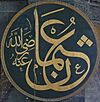 |
|
|
Banu Umayya |
|
| 20 June 656 – 29 January 661 | Ali (علي) |
 |
|
|
Banu Hashim |
Images for kids
See also
 In Spanish: Califato ortodoxo para niños
In Spanish: Califato ortodoxo para niños
- The Four Companions
- Islamic Golden Age
- Talut
- The ten to whom Paradise was promised
- Timeline of Medina
Sources
- Treadgold, Warren (1988). [Rashidun Caliphate at Google Books The Byzantine Revival, 780–842]. Stanford, California: Stanford University Press. p. 268. ISBN 978-0-8047-1462-4. Rashidun Caliphate at Google Books.
- Vasiliev, Alexander A. (1935) (in French). Byzance et les Arabes, Tome I: La dynastie d'Amorium (820–867). Corpus Bruxellense Historiae Byzantinae. French ed.: Henri Grégoire, Marius Canard. Brussels: Éditions de l'Institut de philologie et d'histoire orientales. p. 90. OCLC 181731396.




